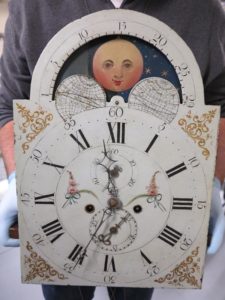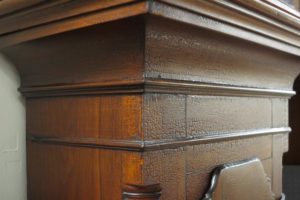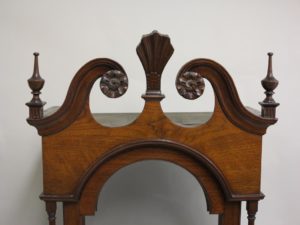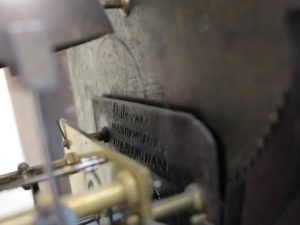Trust Grant Underwrites Conservation of Winchester Clock
By A. NICHOLAS POWERS, Curator of Collections, Museum of the Shenandoah Valley
Earlier this fall, the Decorative Arts Trust followed settlers down the Great Wagon Road to explore the Shenandoah Valley of Virginia. In addition to the marks the Valley’s decorative arts indelibly made on Trust participants, the Trust’s generosity will, in turn, have a lasting impact on the Museum of the Shenandoah Valley’s growing collection of regional decorative arts. With the help of a grant from the Trust, the MSV will conserve the finish of an important, late-18th-century tall case clock attributed to the Duffield-Pyles school of Winchester.
The clock entered the MSV collection in 2014, acquired from an important Shenandoah Valley private collection. With its carved rosettes, arched stop-fluted quarter columns, and applied quarter fans in the paneled base, the case is an excellent example of the sophisticated shop traditions that developed in Winchester after the Revolution. Journeymen of various ethnicities and religions emigrated from southeastern Pennsylvania, Maryland, and elsewhere and congregated in what was the largest town west of the Blue Ridge Mountains, forming one of the most culturally diverse schools of cabinetmaking in the early South. The clock case’s defining characteristic is an outstanding and unique shell-carved center finial that relates to features found on clocks from Chester County, PA, evidence for regional influences within a larger cabinetmaking tradition.
Although unsigned, the English-style clock works closely resemble documented examples made by clockmaker Goldsmith Chandlee, the son of Nottingham, PA, clockmaker Benjamin Chandlee, Jr. Goldsmith was arguably the Valley’s most ambitious clockmaker and one of the few Southern artisans producing mathematical and surveying instruments. Signed examples of Chandlee’s work are in the MSV collection.
While acquired for its importance to the Winchester school of cabinetmaking, the clock has yet to be placed on view because of its condition. In a previous life, the clock stood sentinel in the lobby of Winchester’s Farmers & Merchants Bank, exposing it to years’ worth of direct sunlight that caused the finish to degrade. Sometimes called “alligatoring” because of the pattern it creates, the damage obscures the beautifully figured, and probably locally sourced, walnut used in the tympanum, case door, and base panel. The conservator faces the delicate task of reducing the alligatored appearance while preserving as much finish as possible.
On behalf of the MSV, I would like to extend my thanks to the Decorative Arts Trust for helping my institution and others like us care for our collections and make them more accessible to the public. Upon completion of the conservation treatment, the clock will become an integral part of the galleries Trust members enjoyed during the symposium. I look forward to sharing with you the result of the clock’s “face lift” at a future Trust event.
SAVE THE DATE
- Special Symposium
“Classical Splendor”
The Philadelphia Museum of Art
November 4, 2016 - New York Antiques Weekend
January 20-21, 2017 - Spring Symposium
Savannah
April 21-24, 2017 - Spring Study Trip Abroad
Scotland
May 14-22, 2017 - Fall Symposium
Hartford & Western Connecticut
September 2017 - Fall Study Trip Abroad
Venice and the Veneto
October 9-16 and 22-29, 2017
By A. NICHOLAS POWERS, Curator of Collections, Museum of the Shenandoah Valley
Earlier this fall, the Decorative Arts Trust followed settlers down the Great Wagon Road to explore the Shenandoah Valley of Virginia. In addition to the marks the Valley’s decorative arts indelibly made on Trust participants, the Trust’s generosity will, in turn, have a lasting impact on the Museum of the Shenandoah Valley’s growing collection of regional decorative arts. With the help of a grant from the Trust, the MSV will conserve the finish of an important, late-18th-century tall case clock attributed to the Duffield-Pyles school of Winchester.
The clock entered the MSV collection in 2014, acquired from an important Shenandoah Valley private collection. With its carved rosettes, arched stop-fluted quarter columns, and applied quarter fans in the paneled base, the case is an excellent example of the sophisticated shop traditions that developed in Winchester after the Revolution. Journeymen of various ethnicities and religions emigrated from southeastern Pennsylvania, Maryland, and elsewhere and congregated in what was the largest town west of the Blue Ridge Mountains, forming one of the most culturally diverse schools of cabinetmaking in the early South. The clock case’s defining characteristic is an outstanding and unique shell-carved center finial that relates to features found on clocks from Chester County, PA, evidence for regional influences within a larger cabinetmaking tradition.
Although unsigned, the English-style clock works closely resemble documented examples made by clockmaker Goldsmith Chandlee, the son of Nottingham, PA, clockmaker Benjamin Chandlee, Jr. Goldsmith was arguably the Valley’s most ambitious clockmaker and one of the few Southern artisans producing mathematical and surveying instruments. Signed examples of Chandlee’s work are in the MSV collection.
While acquired for its importance to the Winchester school of cabinetmaking, the clock has yet to be placed on view because of its condition. In a previous life, the clock stood sentinel in the lobby of Winchester’s Farmers & Merchants Bank, exposing it to years’ worth of direct sunlight that caused the finish to degrade. Sometimes called “alligatoring” because of the pattern it creates, the damage obscures the beautifully figured, and probably locally sourced, walnut used in the tympanum, case door, and base panel. The conservator faces the delicate task of reducing the alligatored appearance while preserving as much finish as possible.
On behalf of the MSV, I would like to extend my thanks to the Decorative Arts Trust for helping my institution and others like us care for our collections and make them more accessible to the public. Upon completion of the conservation treatment, the clock will become an integral part of the galleries Trust members enjoyed during the symposium. I look forward to sharing with you the result of the clock’s “face lift” at a future Trust event.





